airbag HONDA CIVIC HYBRID 2014 9.G Owners Manual
[x] Cancel search | Manufacturer: HONDA, Model Year: 2014, Model line: CIVIC HYBRID, Model: HONDA CIVIC HYBRID 2014 9.GPages: 377, PDF Size: 17.8 MB
Page 1 of 377

Contents
This owner’s manual should be considered a permanent part of the
vehicle and should remain with the vehicle when it is sold.
This owner’s manual covers all models of your vehicle. You may find
descriptions of equipment and features that are not on your
particular model.
Images throughout this owner’s manual (including the front cover)
represent features and equipment that are available on some, but
not all, models. Your particular mo del may not have some of these
features.
This owner’s manual is for vehicles sold in the United States and
Canada.
The information and specifications in cluded in this publication were
in effect at the time of approval for printing. Honda Motor Co., Ltd.
reserves the right, however, to discontinue or change specifications
or design at any time without notice and without incurring any
obligation.2 Safe Driving P. 27
For Safe Driving P. 28 Seat Belts P. 32 Airbags P. 39
2Instrument Panel P. 67
Indicators P. 68Gauges and intelligent Multi-Information Display (i-MID) P. 84
2Controls P. 101
Clock P. 102 Locking and Unlocking the Doors P. 103
Operating the Switches Around the Steering Wheel P. 121
Interior Lights/Interior Convenience Items P. 139
2 Features P. 147
Audio System P. 148 Audio System Basic Operation P. 154
Customized Features P. 192 Bluetooth® HandsFreeLink ® P. 205
2 Driving P. 231
Before Driving P. 232 Towing a Trailer P. 237
Rearview Camera P. 272 Refueling P. 273 Fuel Economy P. 276
2Maintenance P. 279
Before Performing Maintenance P. 280 Maintenance MinderTM P. 283
Checking and Maintaining Wiper Blades P. 306
Climate Control System Maintenance P. 319
2Handling the Unexpected P. 325
Tools P. 326 If a Tire Goes Flat P. 327
Overheating P. 347 Indicator, Coming On/Blinking P. 349
2Information P. 357
Specifications P. 358 Identification Numbers P. 360
Emissions Testing P. 363 Warranty Coverages P. 365
14 CIVIC IMA-31TR26200.book 0 ページ 2013年12月23日 月曜日 午後4時9分
Page 5 of 377
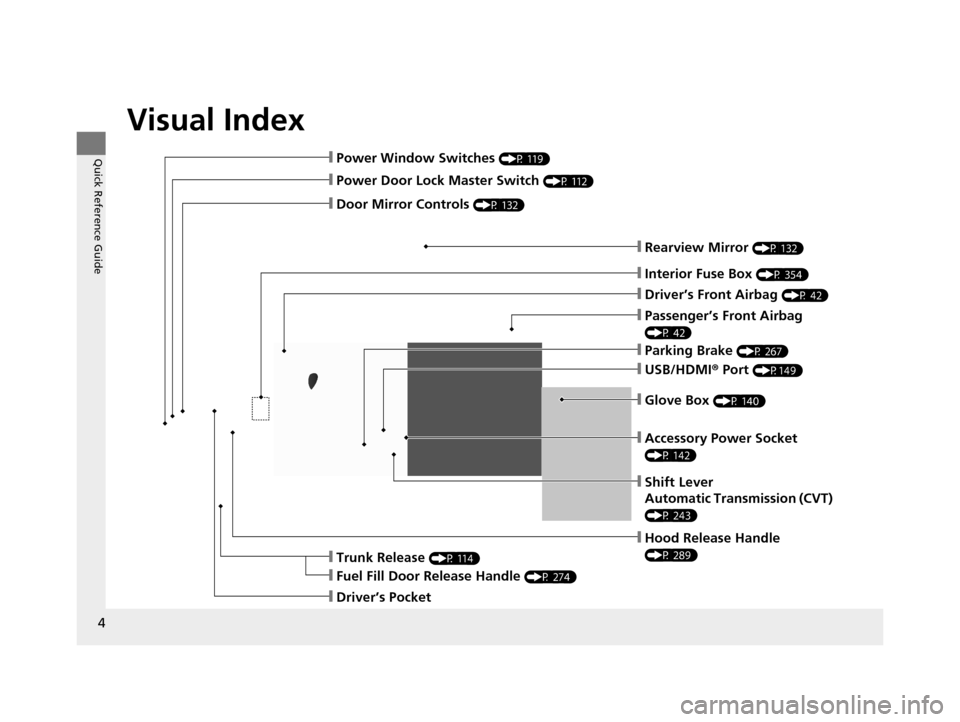
Visual Index
4
Quick Reference Guide
❙Hood Release Handle
(P 289)
❙Power Window Switches (P 119)
❙Power Door Lock Master Switch (P 112)
❙Door Mirror Controls (P 132)
❙Parking Brake (P 267)
❙USB/HDMI® Port (P149)
❙Glove Box (P 140)
❙Shift Lever
Automatic Transmission (CVT)
(P 243)
❙Interior Fuse Box (P 354)
❙Trunk Release (P 114)
❙Driver’s Front Airbag (P 42)
❙Fuel Fill Door Release Handle (P 274)
❙Driver’s Pocket
❙Rearview Mirror (P 132)
❙Passenger’s Front Airbag
(P 42)
❙Accessory Power Socket
(P 142)
14 CIVIC IMA-31TR26200.book 4 ページ 2013年12月23日 月曜日 午後4時9分
Page 6 of 377
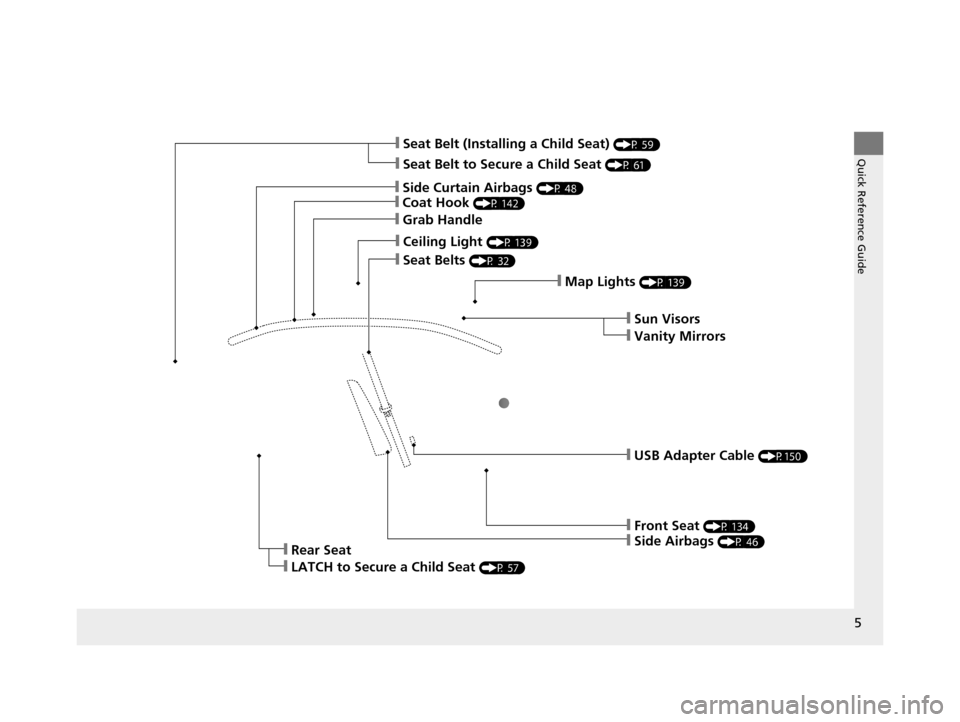
5
Quick Reference Guide
❙Side Curtain Airbags (P 48)
❙Coat Hook (P 142)
❙Grab Handle
❙Ceiling Light (P 139)
❙Seat Belts (P 32)
❙Map Lights (P 139)
❙Front Seat (P 134)
❙Side Airbags (P 46)
❙Seat Belt to Secure a Child Seat (P 61)
❙Seat Belt (Installing a Child Seat) (P 59)
❙Sun Visors
❙Vanity Mirrors
❙Rear Seat
❙LATCH to Secure a Child Seat (P 57)
❙USB Adapter Cable (P150)
14 CIVIC IMA-31TR26200.book 5 ページ 2013年12月23日 月曜日 午後4時9分
Page 13 of 377
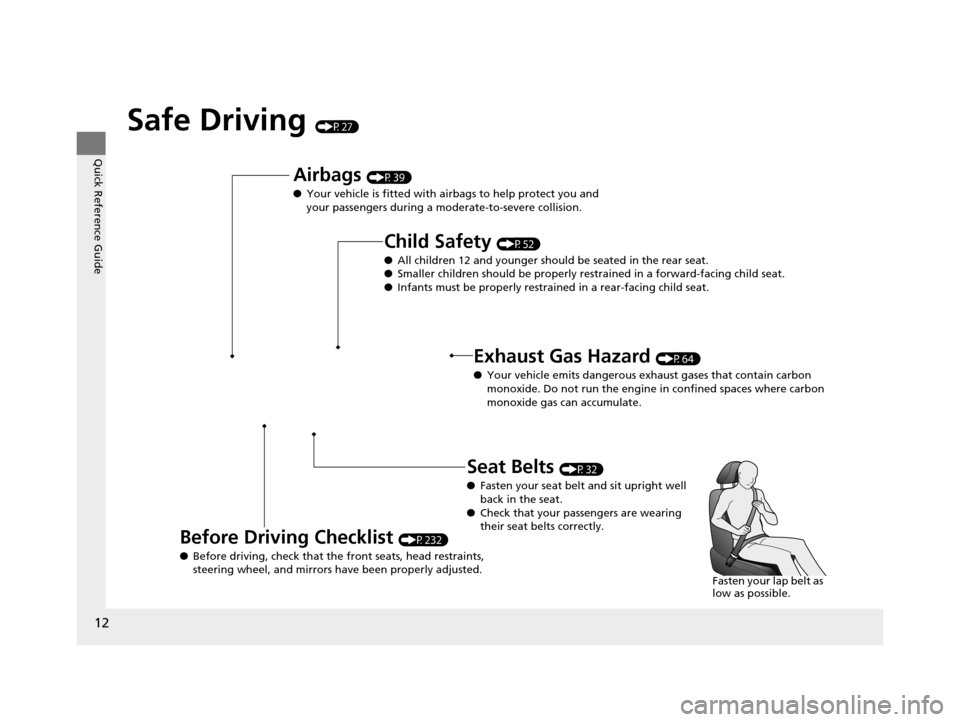
12
Quick Reference Guide
Safe Driving (P27)
Airbags (P39)
● Your vehicle is fitted with ai rbags to help protect you and
your passengers during a moderate-to-severe collision.
Child Safety (P52)
● All children 12 and younger should be seated in the rear seat.
● Smaller children should be properly restra ined in a forward-facing child seat.
● Infants must be properly restrained in a rear-facing child seat.
Exhaust Gas Hazard (P64)
● Your vehicle emits dangerous exhaust gases that contain carbon
monoxide. Do not run the engine in confined spaces where carbon
monoxide gas can accumulate.
Before Driving Checklist (P232)
● Before driving, check that the front seats, head restraints,
steering wheel, and mirrors have been properly adjusted.
Seat Belts (P32)
● Fasten your seat belt and sit upright well
back in the seat.
● Check that your passengers are wearing
their seat belts correctly.
Fasten your lap belt as
low as possible.
14 CIVIC IMA-31TR26200.book 12 ページ 2013年12月23日 月曜日 午後4時9分
Page 25 of 377
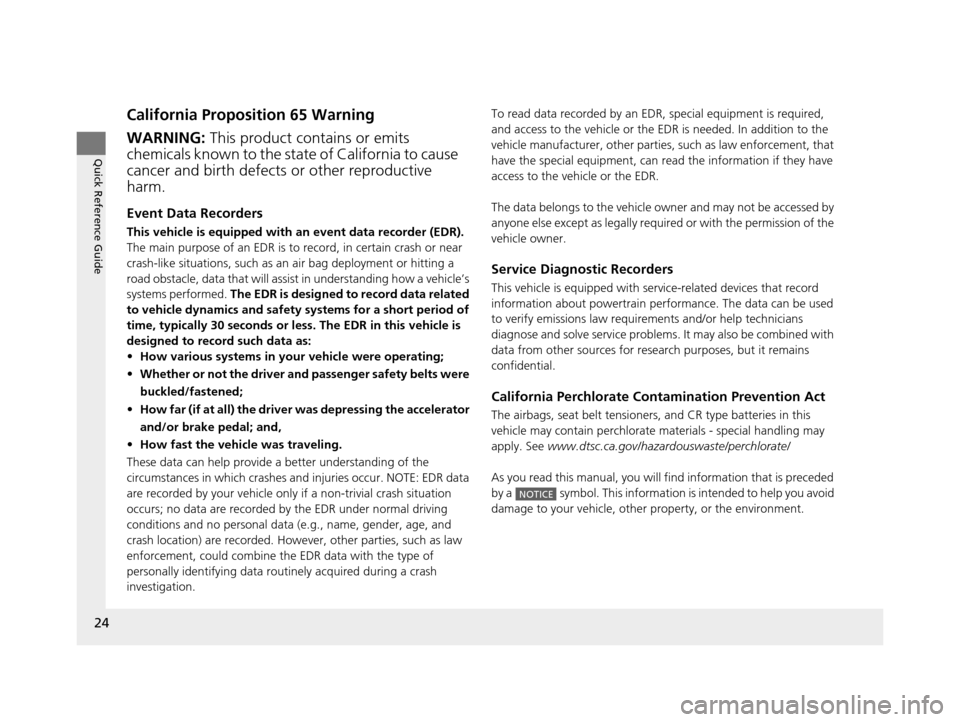
24
Quick Reference Guide
California Proposition 65 Warning
Event Data Recorders
This vehicle is equipped with an event data recorder (EDR).
The main purpose of an EDR is to record, in certain crash or near
crash-like situations, such as an air bag deployment or hitting a
road obstacle, data that will assi st in understanding how a vehicle’s
systems performed. The EDR is designed to record data related
to vehicle dynamics and safety systems for a short period of
time, typically 30 seconds or le ss. The EDR in this vehicle is
designed to record such data as:
• How various systems in your vehicle were operating;
• Whether or not the driver and passenger safety belts were
buckled/fastened;
• How far (if at all) the driver was depressing the accelerator
and/or brake pedal; and,
• How fast the vehicle was traveling.
These data can help provide a better understanding of the
circumstances in which crashes and injuries occur. NOTE: EDR data
are recorded by your vehicle only if a non-trivial crash situation
occurs; no data are recorded by the EDR under normal driving
conditions and no personal data (e.g., name, gender, age, and
crash location) are recorded. Howe ver, other parties, such as law
enforcement, could combine the EDR data with the type of
personally identifying data routinely acquired during a crash
investigation.
WARNING: This product contains or emits
chemicals known to the state of California to cause
cancer and birth defects or other reproductive
harm.
To read data recorded by an ED R, special equipment is required,
and access to the vehicle or the EDR is needed. In addition to the
vehicle manufacturer, other parties, such as law enforcement, that
have the special equipment, can re ad the information if they have
access to the vehicle or the EDR.
The data belongs to the vehicle ow ner and may not be accessed by
anyone else except as legally requ ired or with the permission of the
vehicle owner.
Service Diagnostic Recorders
This vehicle is equipped with serv ice-related devices that record
information about powertrain perform ance. The data can be used
to verify emissions law requirem ents and/or help technicians
diagnose and solve service problems. It may also be combined with
data from other sources for res earch purposes, but it remains
confidential.
California Perchlorate Contamination Prevention Act
The airbags, seat belt tensioners , and CR type batteries in this
vehicle may contain perchlorate materials - special handling may
apply. See www.dtsc.ca.gov/hazardouswaste/perchlorate/
As you read this manual, you will find information that is preceded
by a symbol. This information is intended to help you avoid
damage to your vehicle, othe r property, or the environment.
NOTICE
14 CIVIC IMA-31TR26200.book 24 ページ 2013年12月23日 月曜日 午後4時9分
Page 28 of 377

27
Safe Driving
You can find many safety recommendations throughout this chapter, and throughout this manual.
For Safe DrivingImportant Safety Precautions ............. 28
Your Vehicle’s Safety Features............ 30
Seat Belts About Your Seat Belts ........................ 32
Fastening a Seat Belt .......................... 35
Seat Belt Inspection............................ 38
Airbags Airbag System Components ............... 39
Types of Airbags ................................ 42
Front Airbags (SRS) ............................ 42
Side Airbags....................................... 46 Side Curtain Airbags .......................... 48
Airbag System Indicators.................... 49
Airbag Care ....................................... 51
Child Safety Protecting Child Passengers ............... 52
Safety of Infants a nd Small Children .. 54
Safety of Larger Children ................... 62
Exhaust Gas Hazard Carbon Monoxide Gas ....................... 64
Safety Labels Label Locations .................................. 65
14 CIVIC IMA-31TR26200.book 27 ページ 2013年12月23日 月曜日 午後4時9分
Page 29 of 377
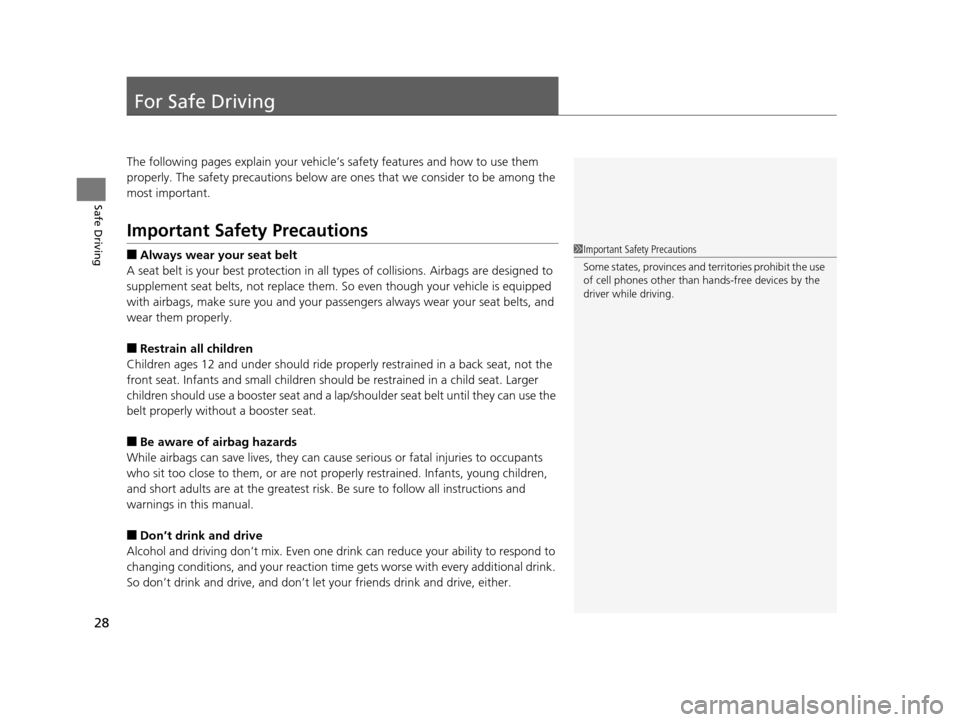
28
Safe Driving
For Safe Driving
The following pages explain your vehicle’s safety features and how to use them
properly. The safety precauti ons below are ones that we consider to be among the
most important.
Important Safety Precautions
■Always wear your seat belt
A seat belt is your best protection in all types of collisions. Airbags are designed to
supplement seat belts, not replace them. So even though your vehicle is equipped
with airbags, make sure you and your passe ngers always wear your seat belts, and
wear them properly.
■Restrain all children
Children ages 12 and under should ride properly restrained in a back seat, not the
front seat. Infants and small children shoul d be restrained in a child seat. Larger
children should use a booster seat and a lap/shoulder seat belt until they can use the
belt properly without a booster seat.
■Be aware of airbag hazards
While airbags can save lives, they can cause serious or fatal injuries to occupants
who sit too close to them, or are not prop erly restrained. Infants, young children,
and short adults are at the greatest risk. Be sure to follow all instructions and
warnings in this manual.
■Don’t drink and drive
Alcohol and driving don’t mix. Even one dr ink can reduce your ability to respond to
changing conditions, and your reaction time gets worse with every additional drink.
So don’t drink and drive, and don’t let your friends drink and drive, either.
1Important Safety Precautions
Some states, provinces and territories prohibit the use
of cell phones other than hands-free devices by the
driver while driving.
14 CIVIC IMA-31TR26200.book 28 ページ 2013年12月23日 月曜日 午後4時9分
Page 31 of 377
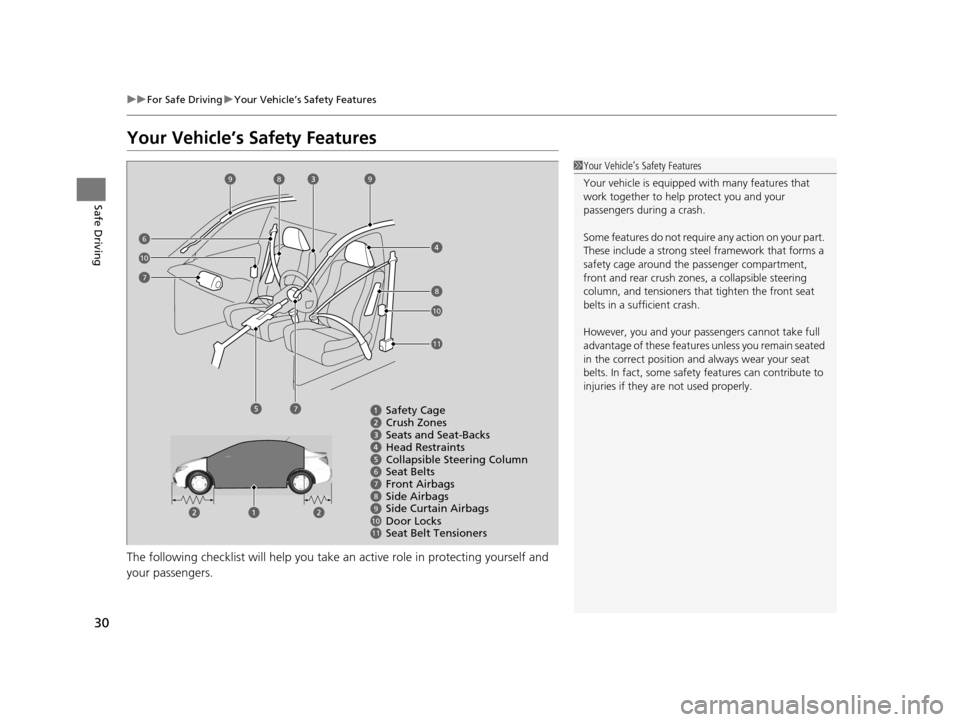
30
uuFor Safe Driving uYour Vehicle’s Safety Features
Safe Driving
Your Vehicle’s Safety Features
The following checklist will help you take an active role in protecting yourself and
your passengers.
1 Your Vehicle’s Safety Features
Your vehicle is equipped wi th many features that
work together to help protect you and your
passengers during a crash.
Some features do not require any action on your part.
These include a strong steel framework that forms a
safety cage around the passenger compartment,
front and rear crush zone s, a collapsible steering
column, and tensioners that tighten the front seat
belts in a sufficient crash.
However, you and your passe ngers cannot take full
advantage of these features unless you remain seated
in the correct position and always wear your seat
belts. In fact, some safety features can contribute to
injuries if they are not used properly.
67891011
Safety Cage
Crush Zones
Seats and Seat-Backs
Head Restraints
Collapsible Steering Column
Seat Belts
Front Airbags
Side Curtain Airbags
Seat Belt Tensioners Side Airbags
6
7
7
8
8
99
10
11
Door Locks
10
14 CIVIC IMA-31TR26200.book 30 ページ 2013年12月23日 月曜日 午後4時9分
Page 32 of 377

31
uuFor Safe Driving uYour Vehicle’s Safety Features
Safe DrivingFor the safety of you and your passengers, make a habit of checking these items
each time before you drive.
• After everyone has entered the vehicle, be sure all doors are closed and locked.
Locking the doors helps prevent an occupant from being ejected and an outsider
from unexpectedly opening a door.
2 Locking/Unlocking the Doors from the Inside P. 110
•Adjust your seat to a position suitable for driving. Be sure the front seats are
adjusted as far to the rear as possible while allowing the driver to control the
vehicle. Sitting too close to a front airbag can result in serious or fatal injury in a
crash.
2 Adjusting the Seats P. 134
•Adjust head restraints to the proper position. Head restraints are most effective
when the center of the head restraint aligns with the center of your head. Taller
persons should adjust their head restraint to the highest position.
2 Adjusting the Head Restraints P. 136
•Always wear your seat belt, and make sure you wear it properly. Confirm that any
passengers are properly belted as well.
2 Fastening a Seat Belt P. 35
•Protect children by using seat belts or chil d seats according to a child’s age, height
and weight.
2 Child Safety P. 52
■Safety Checklist1Safety Checklist
If the door open indicator is on, a door is not
completely closed. Close all doors tightly until the
indicator goes off.
2 Door Open Indicator P. 72
14 CIVIC IMA-31TR26200.book 31 ページ 2013年12月23日 月曜日 午後4時9分
Page 33 of 377
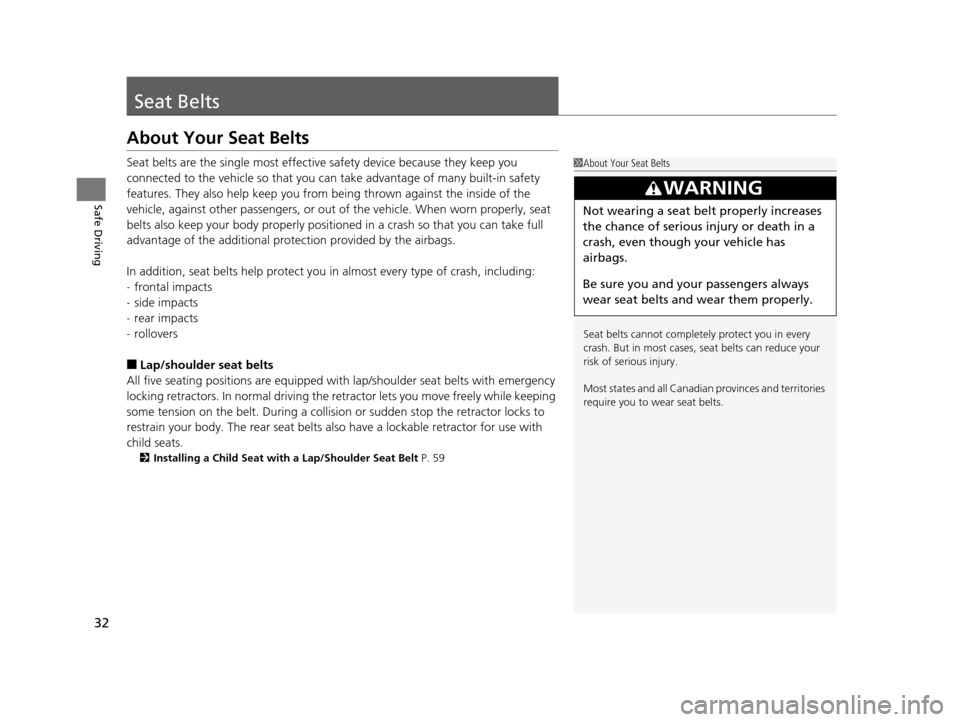
32
Safe Driving
Seat Belts
About Your Seat Belts
Seat belts are the single most effective safety device because they keep you
connected to the vehicle so that you can take advantage of many built-in safety
features. They also help keep you from be ing thrown against the inside of the
vehicle, against other passengers, or out of the vehicle. When worn properly, seat
belts also keep your body pr operly positioned in a crash so that you can take full
advantage of the additional protec tion provided by the airbags.
In addition, seat belts help protect you in almost every type of crash, including:
- frontal impacts
- side impacts
- rear impacts
- rollovers
■Lap/shoulder seat belts
All five seating positions are equipped with lap/shoulder seat belts with emergency
locking retractors. In normal driving the re tractor lets you move freely while keeping
some tension on the belt. During a collision or sudden stop the retractor locks to
restrain your body. The rear seat belts al so have a lockable retractor for use with
child seats.
2 Installing a Child Seat with a Lap/Shoulder Seat Belt P. 59
1About Your Seat Belts
Seat belts cannot complete ly protect you in every
crash. But in most cases, seat belts can reduce your
risk of serious injury.
Most states and all Canadian provinces and territories
require you to w ear seat belts.
3WARNING
Not wearing a seat belt properly increases
the chance of serious injury or death in a
crash, even though your vehicle has
airbags.
Be sure you and your passengers always
wear seat belts and wear them properly.
14 CIVIC IMA-31TR26200.book 32 ページ 2013年12月23日 月曜日 午後4時9分